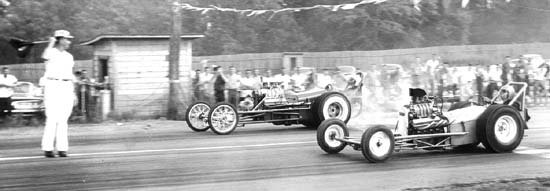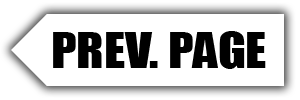Sneaky Pete Robinson, Part 2
 In early spring 1961 Pete Robinson and Bill Word took their new AA/Dragster to the NHRA Southeast Division meet at Newton County Dragway, in Covington, Ga., just east of Atlanta. Despite some new-car mechanical problems they managed to win Top Eliminator. In the Top Eliminator final Pete stopped Billy Douglas, from Chattanooga, Tenn., with an 8.98 at 168.48. Douglas’ car shows plenty of backyard “ingenuity in action” with chain-driven, GMC 4-71 blown Chevy, shorty homemade chassis and steel wheels all around. |
In case you missed it, read Part 1 here.
In spring 1961 Robinson and Word began running their new AA/Gas Dragster at near-by local tracks. There were initial difficulties in tuning the somewhat odd combination, brought about by the high compression ratio and greater spark advance that the team began with.
Bill Word remembers that Pete wanted to run 38-40 degrees of spark advance in the Vertex magneto ignition, as he had done with his blown Buick. They quickly discovered that the Chevy heads were much more efficient than the Buick, and required considerably less spark advance to produce maximum power. As they backed down the spark advance the car began to really haul.
“It was really amazing. We took timing out of the engine and the car really started to move. Surprisingly, it was not only quicker off the line but all the way down track, and it even ran more top-end mph. We began by running higher compression than other blown cars, so we found out that there was a point where spark advance actually slowed the car. Soon as we got that figured out we knew were onto something”, Word recalled.
Pete and Bill took the car to the local NHRA Division 2 points meet at Covington, Georgia, just east of Atlanta. Their first “big meet” rewarded them with a Top Eliminator trophy against a solid field of other AA Dragsters. They also racked up a number of high eight-second times on a slippery track surface. Other outings netted ever lower ET’s coupled with increasing speeds. The car proved to be quick, fast and consistently capable of running eight-second ET’s at or above 170 mph. These numbers were very competitive for 1961’s gas-only NHRA drag racing.
It was during this first “big meet” that Pete and Bill discovered that the unusually high compression ratio they were running was the cause of the parts damage they were experiencing.
“The car was running hard, but it was hurting itself too”, Bill Word remembered. “When we took the engine apart the rings were falling out in pieces, so we knew we had a problem to fix. We started to back down the spark advance, and surprisingly, the more advance we took out, the faster the car ran, and without damaging parts. We just couldn’t run the same spark advance the other guys were using, because our engine had that much more compression”, according to Word.
By late summer, 1961, the little Chevy engine was running hard and by then holding together well, with no major issues. Main and rod bearings were happy, the piston ring breakage was gone and the valve train continued to function without problems. As the entry deadline neared, Bill and Pete decided to see how their new creation matched up with the other top dogs, and mailed their entry to the nation’s largest, most prestigious drag race, the ’61 NHRA Nationals.
Held over Labor Day weekend, 1961 would be the first year the race was held at the brand new Indianapolis Raceway Park facilities. Previous Nationals events had been held in Kansas, Oklahoma and most recently, at Detroit Dragway. Located just west of the historic Indianapolis Motor Speedway, Raceway Park was the first new “super track” of the decade. Hosting The Nationals was a brightly colored feather in IRP’s cap. Its Midwestern, center-of-the-nation location guaranteed it would attract loads of the country’s best competitors. Track surfaces were smooth, wide and some 3,700 feet long, guaranteeing that times would be equal to the splendor of the surroundings.
The unlikely pair of Robinson and Word rolled into the track unknown and unheralded, anxious to see how their odd combination might fare against the best in the nation. The reaction they received was decidedly cool.


